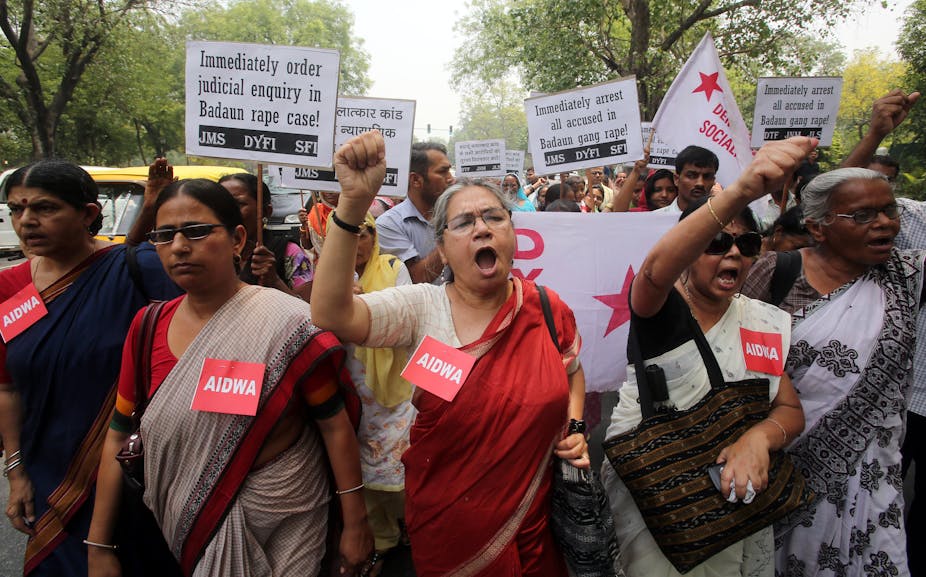It’s almost 80 years since Abel Meeropol’s powerfully evocative civil rights poem Strange Fruit was popularised in song by Billie Holiday. But I recalled the lyrics recently, when reading about the high-profile rape cases in India that have begun steadily to filter into the global media.
“Southern trees bear strange fruit,” sang Holiday. “Blood on the leaves and blood at the root … Here is a strange and bitter crop.”
Rather than black lynching in the American south, the “strange fruit” hanging from trees in India are raped and abused women and girls, and 2014 looks to be a bumper year for this horrific harvest. Reading the reports, certain place names – Chhattisgarh and Madhya Pradesh – struck a particular chord with me. These are places where, in researching my book on the literary and cultural history of the vagina, I had encountered some of the earliest and most violent tales of the brutalisation of women. I’d treated those stories as scraps, merely remnants of an oral tradition which had few echoes in modern culture and which were safely consigned to the archives of misogyny.
But I was wrong – the same stories reverberate in India today, albeit in different words. In one of the first news stories widely reported outside India, a woman was raped and murdered by a group of men on a bus in Delhi in 2012. Since then, images of murdered Indian women have become more and more common – and more noticed – and it’s perhaps little surprise given the views of some of the country’s politicians.
Ramsewak Paikra is minister for law and order in Chhattisgarh, an Indian state whose population tops 25 million, and a member of BJP, India’s ruling party. Paikra’s statement this month that rapes “do not happen deliberately” was widely reported. “These kinds of incidents happen accidentally,” he said.
Chhattisgarh’s geographical neighbour is Madhya Pradesh, a massive state with three times the number of inhabitants. Its home minister is Babulal Gaur, also a BJP member, also an apologist for rape. In January he declared that fewer rapes were reported in Chennai because women there dress more modestly, and act more piously, than women in other Indian states.
It wasn’t that much of a surprise, then, when Gaur felt compelled to respond to the murder and apparent rape of two young girls found last month hanging from a mango tree in the Badaun district of Uttar Pradesh (the children had gone into the field where their bodies were eventually found because they did not have a lavatory at home). “Sometimes rape’s right,” he said, “sometimes it’s wrong.”
Myths made real
When men fear women, they silence them. They rape and murder them, enacting on their victims’ bodies a furious revenge. Stories of this revenge go back generations in Madhya Pradesh where a Baiga myth tells of a woman whose vagina punishes men by amputating their penises. In the story, this mythical castration by the equally mythical “toothed vagina”, or vagina dentata, leads to a wealthy landlord commanding four men of other castes to rape and subdue the woman.
One of the men “held the girl down, and the Baiga thrust his flint into her vagina and knocked out one of the teeth. The Agaria inserted his tongs and pulled out the other two. The girl wept with the pain, but she was consoled when the landlord came in and said that he would now marry her immediately”. The idea of the marriage of consolation is almost as shocking as the idea that a woman’s sexuality and identity must be somehow forcibly tamed. In yet another story from Madhya Pradesh, a young man has his penis reinstated by the woman whose vagina amputated it; in return he extracts her “teeth”.
In a ground-breaking anthropological article of the early 1940s, the missionary-turned-anthropologist Verrier Elwin cited many examples of the retelling of the vagina dentata myth arising from his extensive travels in the Indian subcontinent.
Most of the tales originate with the Baiga people and, each time, despite a little local colour, the vagina is a dark and vicious place. Again in Madhya Pradesh, the wife of an Agaria is attacked by a group of young men; a snake emerges from her mouth and is killed; penises magically regrow when sprinkled with ground-up vaginal tooth powder; and a woman is cooked in a broth, the aroma of which kills the men.
Elwin’s accounts often featured phallic objects which were used to neutralise the vagina dentata. In a town called Dantinpur (the ominously-named “Tooth City”), a custom-made iron penis dislodges offending fangs; and an angry tigress-woman is transmuted into a Chamgedri (a being with one orifice for all bodily functions).
In Chhattisgarh, a snake enters a woman via her vagina, and bites off the penis of a young man who attempts to rape her. Three of his brothers meet the same fate; it is up to the youngest one to extract the snake with a stick, on condition that it magically reinstate his brothers’ penises.
Repeatedly, the stories focus on the necessity of subduing women; of violently forcing them into death or marriage, having first – usually – sadistically knocked the “teeth” out of their vaginas.
Misogyny in India, then, has a long genealogy. Economic privation and a punitive, divisive caste system mean that the lives of many millions of women there are short and brutish. Violence against women and girls is deeply inscribed in languages and culture. A rape is reported in India almost once every 20 minutes – in a population of well over one billion people, it’s beyond doubt that an unimaginably high number of attacks are going unreported. In New Delhi alone, 600 rapes were reported in 2012. In a vastly populated country where ancient myths still reverberate in the public utterances of elected representatives, it is perhaps of little surprise that, of those 600 rapes, only one conviction has – so far – resulted.

